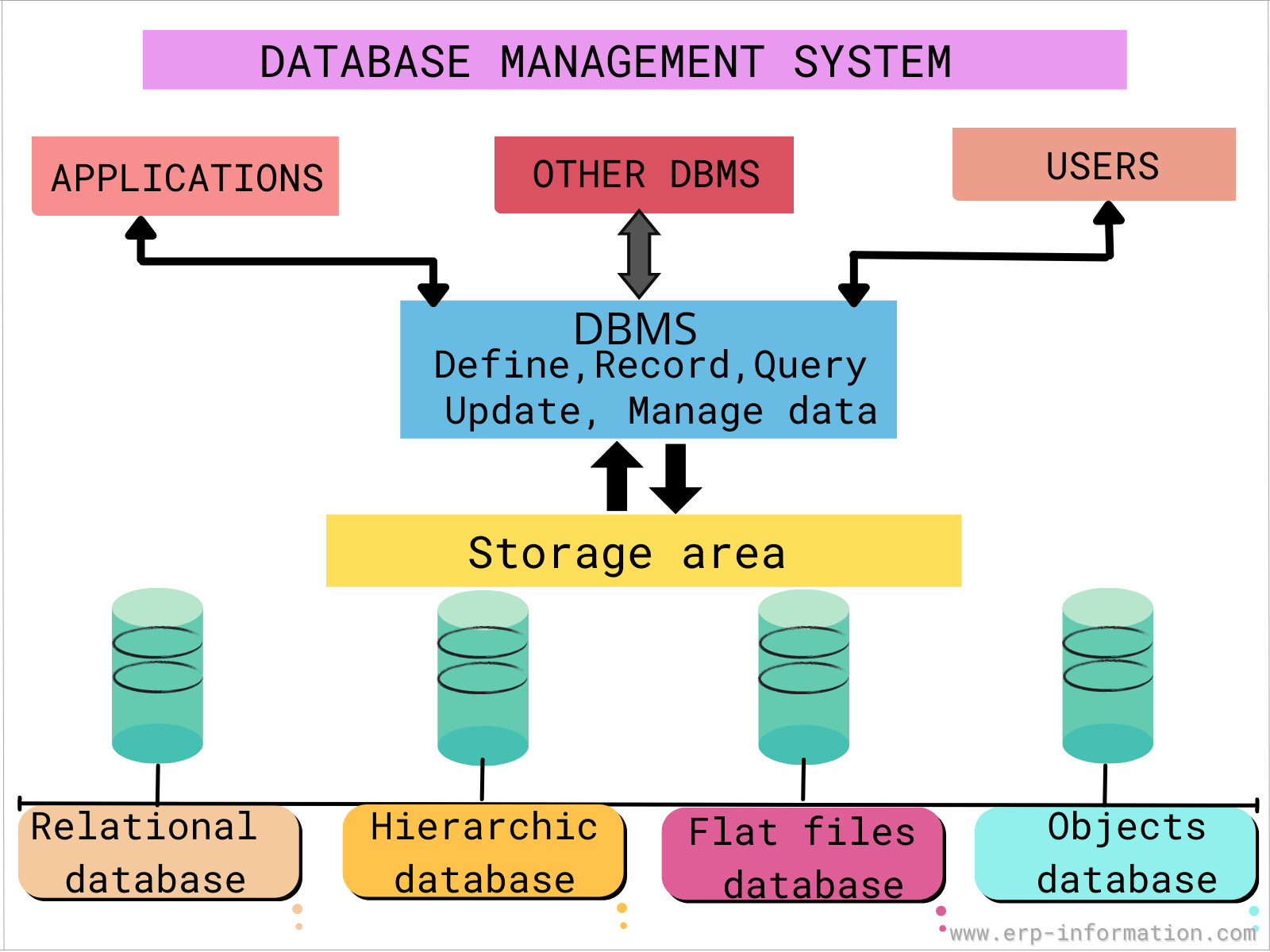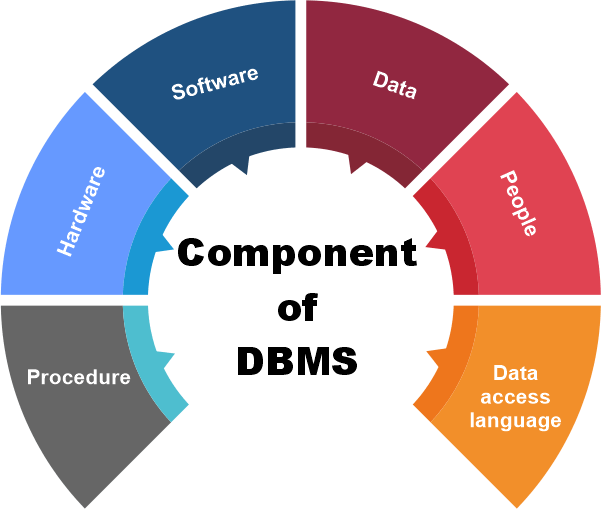Introduction to Database Management Systems (DBMS)
Database management system (DBMS) is a software that is used to manage databases and provide efficient storage, retrieval, and management of data. In other words, DBMS is the software that connects the end-users to the database, ensuring that data will be stored in a structured, well-organized way and will be accessed and updated in an efficient manner.
DBMS is becoming more and more important with the digitization of data in today’s world which is the underlying factor for a full economy although it does not quite affect the way businesses, governments, and other organizations are run all over the world. In this article, we will thoroughly explain DBMS i.e. the definition of it, the reason for its existence, its architecture, and what each of the DBMS component is.

What is a Database?
- DBMS can be best explained by using the term database.
- The database suggests that a database is an assortment of data interconnected each other and it is shaped in such a way that it can be easily stored, retrieved, and manipulated.
- According to a database, you can save diverse information, like numbers, text, and pictures, in one device which has various arranged files.
For example, a computer college might aggregate studdetails, staff data like faculty, the datashow and the enrollments etc. The data are distributed in the different tables, with a specific table being the inventory of each item. Thereby, a student table would contain the id of the student, name, age, and courses which he/she is enrolled in. At the same time, the teacher table has the columns with the faculty id, name, department, and the courses he/ she teach.
Why Do We Need a DBMS?
- The inevitable thing is, if we had to handle it ourselves, we would have to endure a great deal of data management, as the size and complexity of data files often cause them to become beyond the capability of human beings to handle them easily.
- Instead of a DBMS, it is impossible to properly execute the large amount of data that might exist, it would be very difficult, prone to errors, and ineffective.
- The main reasons for which a DBMS is essential are the following:
1.Efficient Data Management:
- The DBMS software maintains the data storage part by updating the information, removing the outdated ones, and retrieving the correct data.
- The data organization, storage, and access are provided in a more efficient manner by DBMS tools.
2.Data Redundancy Control:
- Lack of DBMS can allow data redundancy to take place, and what happens in the end is many data copies being the same that are then pushed to the database, causing inconsistency and storage wastage.
- DBMS guarantees the sorting of the data for data redundancy issues as it does this through storing data only at one point and at the same time keeping it consistent.
3.Data Integrity:
- Implementing database rules such as constraints is the way DBMSs ensure that the data is correct.
- Such rules as primary and foreign keys keep data integrity and prevent data wrong entries.
4.Data Security:
- As data is the source of all the schenarios that are threatening the world we have to protect this These attackers always try to steal data and make it impossible to use.
- But there are lots of software and DBMS can give integrity to databases.
- In fact, by providing database management systems, there are strong methods in DBMSs that prevent data loss from unauthorized access by having them pass over in the only way while assuring that they are accompanied with a certain passphraase, modify, or view any sensitive data, all this to be applied only by authorized users who possess some certain keys and tokens.
5.Concurrent Access:
- Suppose, there are these two instances in the system that want to make some changes.
- In this case, the database should provide concurrency control which means that there should be the control of parallelism and isolation to prevent conflicts or the data from being contaminated.
- Control of the access to the backup and recovering from it will be made by concurrency control. The issue of backing up.
6.Backup and Recovery:
- Actually, the expense of the risk incurred is losing the data.
- Our world is moving so fast and the things we utilize is high technology.
- Computers might crash, phones might become dead or your storage media can be broken or lost.
- Built-in backup and recovery mechanisms in the DBMS will ensure that the data is not lost when a system crash occurs or there is a system failure.
7.Data Independence:
- DBMS offers data independence, which means the data is separated from the physical storage and anyone can read it without the need for the exact details of the physical data being stored.
DBMS Architecture: Layers of Data Management
- A DBMS architecture is a data storage, processing, and the DBMS software domesticates of this storage, processing, and data interaction.
- It also refers to how users and applications work with and manipulate data.
- When breaking down the layers, a database management system’s architecture is generally combined by three parts:
1.Internal Level:
- This level is connected to the actual physical storing of data.
- It dictates the way and where data files are saved and how the DBMS manages databases.
- The internal level is dedicated to the performance and quality of data storage.
2.Conceptual Level:
- The conceptual level is nothing but the representation of the overall logic of the entire database.
- A more friendly, easy-to-understand, way of looking at it, it provides users with the opportunity to see the information they need without the burden of lower-level storage issues.
- In simple terms, the conceptual level is about how the data is logically and correctly organized.
3.External Level:
- This level is the layer of a database, which is at the user’s viewpoint. The users’ requirements of a database are the subject of this level.
- Diverse needs are there for various users for the same database. That is, one user might only need access to the student records but an administrator might need access to the entire database.
- External level is data presentation through the interface to the various users, which, in turn, is dependent on the roles and the permissions.
Components of a DBMS
A DBMS can be seen as being made up of a number of different components, which together create efficient data storage. The major components of the DBMS are:

1.Database Engine:
- However, the database is often called the database engine because it is responsible for storing, the data, updating the data, and accessing the data.
- The system ensures that the data is accurate, which is one of the main functions of the storage system; thus, the data can be accepted and retrieved through the system.
2.Database Schema:
- Schema determines the structure of a database which contains the attributes of tables, the definition of relationships, and the data types.
- It is a blueprint for the arrangement and access of data.
3.Query Processor:
- The query processor is software that reads and interprets SQL queries to the database engine, and then processes these requests.
- It translates high-level SQL queries into logical operations that the engine can understand and execute.
4.Transaction Management:
- The transaction management system is accountable for ensuring that all transactions are serialized and that they are performed in the atomic, consistent, isolated, and durable (ACID) way, i.e. it deals with issues such as the control concurrency, the cancellation of changes and the final versioning, among others.
- The former is based on a technology that is developed around data transactions between databases, while the latter is a middleware solution that is designed exclusively around applications.
- So it is fair to say that a middleware solution deals with connections between a web application and a database.
5.Data Dictionary:
- The data dictionary is a collection of data (metadata) that describes the data model and is used to control access to the database.
- It not only contains tables information but also information such as fields, keys, constraints, relationships.
6.Database Access Language (Query Language):
- It is the language that is used by the user and hence the application to get interactive with the database.
- SQL (Structured Query Language) remains the most common example of this type, which allows users to create, retrieve, update, and delete database records.
DBMS Advantages
The implementation of DBMS has the following advantages:
- Data Redundancy Control: DBMS eliminates data redundancy by storing data in a central store and providing a single data definition and format.
- Data Integrity: DBMS controls the correctness of data by the application of various checks and rules thus enabling only the valid data to have been entered into the system.
- Efficient Querying: Advanced query processors in DBMS are the most fast and efficient which allow for faster searching and retrieval of data.
- Data Security: DBMS ensures security through mechanisms such as authentication, authorization, and auditing such that only those with proper permissions have access to data.
- Backup and Recovery: Automated backup and recovery systems will maintain and recover the data to prevent any loss in the case of a failure or disaster.
- Concurrency Control: DBMS takes care of concurrent access of the data by several users and it ensures that no data is lost as a result of simultaneous access by more than one user.
